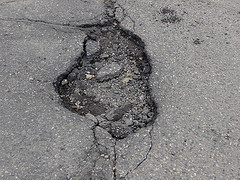Spring has sprung. Across the country, flowers are beginning to peek their way out of nascent bushes. Robins are returning from their winter vacations, and another harbinger of the vernal season has started to emerge from the snow and slush–potholes.
Winter weather doesn’t just take its toll on us human beings; it also plays havoc with our roads. Repeated freezing and thawing can chew up a road surface, filling it with holes, some so deep they can easily swallow up a wheel and tire. Often filled with water that disguises their true size and depth, potholes can cause serious damage to your vehicle.

flic.kr/p/bDwAXX
How should you deal with this menace? We asked the engineers at Ford Motor Company whose Ford, Lincoln, and Mercury vehicles are subject to stringent testing that can reduce the chance of damage caused by chuckholes. To validate its vehicle designs, Ford has designed its proving grounds to offer a wide variety of road conditions, including pavement filled with potholes, and what it describes as “torture devices” to test and improve the durability of the entire vehicle.
Tips for damage prevention
Ford Motor Company has several tips for drivers to help prevent damage to their vehicles from the chuckhole danger:
Pay attention to tire pressure. Keeping tire pressure at the manufacturer’s recommendation will help protect your vehicle’s wheels and tires from being damaged by potholes. Tire pressure varies from vehicle to vehicle and from season to season, so pay close attention by checking your tire pressure with a tire gauge at least once a month.
If you see a pothole at the last minute, resist the urge to swerve to avoid it. Swerving can create a situation where the front wheel and tire on the car can hit the edge of the pothole at an obtuse angle, which might do more damage than hitting it squarely. It might also put you unsafely into another lane of traffic.
If you approach a chuckhole at speed, don’t brake heavily as you near it. Heavy braking compresses the front suspension of the car and will have a tendency to force the tire and wheel down fully into the pothole, potentially causing greater damage than your car might experience if it “skimmed” over it.
Reduce speed if you feel a sudden vibration or ride disturbance. If you can’t avoid a pothole and suspect your tire or vehicle has been damaged from it, immediately slow down but, of course, don’t come to a dead stop on the roadway. Instead drive with caution until you can safely pull off the road to check for damage.
No matter how carefully you drive, there’s always the possibility that you may experience a flat tire on the freeway, Interstate or other highly traveled route. If that occurs, drive slowly to the closest safe area out of the way of traffic. While this may further damage the tire, that expense is not as important as your safety. Unfortunately, each year scores of tire-changers are struck and killed by passing cars.
Good news
While potholes can damage your vehicle, the good news is that vehicle engineers design chassis and suspension components to handle potholes and other imperfections in the road effectively, balancing them for numerous customer driving conditions. To give drivers a fighting chance with monster spring potholes, engineers tune shock rebound rates to keep the wheel and tire suspended for a fraction of a second, helping the driver get through a pothole with minimal or no damage at all.. Good shock absorbers can prevent a tire from fully dropping into the break of the pavement and impacting the edge of the tire and wheel.
With a keen eye for danger and the help of modern suspension technology, you can make certain a chuckhole doesn’t swallow you up this spring.
—Based in Villeperce, France, Driving Today Contributing Editor Tom Ripley covers the auto industry and the human condition, both of which are filled with potholes. © Studio One Networks.
Tagged with: drivers' education • Ford • road safety
Filed under: Good Driving